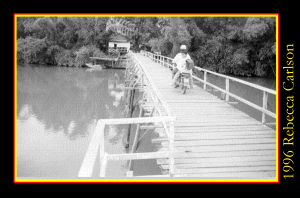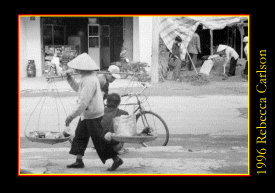The following is based on conversations with Tran Chi Cuong, a Vietnamese born and raised ethnic Chinese man whose grandfather emigrated from the Pear River in China around 1929. Cuong relates the stories of three generations of "boat people"* who share the experiences of those Nanyang Huaquiao, or overseas Chinese of Southeast Asia, referred to as the "boat people". His stories are of the Japanese occupation during World War II, the Vietnam War, Chinese-Vietnamese relations, and most of all what it means to be an economic refugee.
[note: though not literally "boat people" because they did not emigrate by boat, the Trans are one family whose experiences are those of the "boat people" and as such give personality to an otherwise faceless people who we learn of only through an abstract news item.]
 Nha Trang, Vietnam
Nha Trang, Vietnam
![[Becoming a Huaqiao]](pix/bp/bphua.gif)
In 1929, Chan Kung-li decided to leave his small town on the Pearl River, south of Canton, and search for a better life for himself and his family. His eldest child, a girl, had been sold into domestic servitude somewhere in Nanyang, or Southeast Asia. Leaving his eldest son and an additional two daughters left behind in China, and he set off for Vietnam
Prosperity did not come quickly for the immigrant Chan family. They first settled in Sa Déc in the Mekong Delta of Southern Vietnam where Kung-li's cousin owned a small business. The Chans believed this cousin would assist them in getting started in this new country, but the cousin's wife refused to allow her husband to aid the Chans. In the absence of this aid that they had hoped for and expected, they moved to Cho Lon ("big market"), an ethnic Chinese dominated business section of Saigon. Here Kung-li assisted the owner of a small goods store run the business.
The Vietnamization of the Chan family, in as much as it could be said that this did occur in some small part, can be illustrated by the Vietnamization of the names of the Chan immigrants and their offspring in Vietnam.
Kung-li's wife bore him two sons in Vietnam, the second son was named Tho, and his full name was Tran Van Tho. The family name, "Chan", was Vietnamized to "Tran". Tran Van Tho's children were given both Vietnamese and Chinese names, but the Vietnamese names were commonly used in the house and in public.
![[Second Generation]](pix/bp/bpsec.gif)
Tho began working in a glass mill when he was seven-years old. Three years later he started working in a casino. The ethnic Chinese owners were childless and wanted to adopt the boy, but he refused even if they could have provided better for him than his own parents could have. He was too poor to attend school until he was fifteen-years old, when a Chinese family association collected enough funds to start evening classes for disadvantaged children. He had begun working as a waiter at a dim-sum shop about this time, and every night after work he would practice drawing Chinese characters on a table top with a shard of ice.
![[World War II]](pix/bp/bpww2.gif)
Tho was a young boy when the Japanese invaded and occupied Vietnam, but what little he remembered, he passed on to his eldest son. The Japanese soldiers were admired for their remarkable discipline and kindness. A Japanese soldier might be disciplined in public by having his face slapped. Tho saw an officer helping common soldiers "fox"-holes shoulder-to-shoulder. He would mention this years later when comparing the way American officers reigned over their subordinates. Tho also recalled a time when a Japanese soldier gently patted him on his head and offered him candy. Still, the Japanese occupation of Vietnam does not hold only pleasant memories for this naïve young boy. After Japan's surrender, but prior to the arrival of the Allied forces, Japanese soldiers went on a rampage, raping ethnic Chinese women [it seems perversely odd that an ethnic distinction was made in these war-time depredations though this is how the story was handed down accompanied by an explanation that Chinese were de-facto orphaned in a foreign land].
The first representatives of the Allied armies to arrive in Saigon were Ghurka soldiers originally from the English colony of India and they began to rape the ethnic Chinese women just as the Japanese had before them. The Japanese occupation was a striking contrast to the position accorded the colonial lords just prior to the Japanese invasion. An image which foreshadowed the realization of a Vietnamese national self-determination decades later emerged when the Vietnamese and ethnic Chinese saw Allied soldiers gaunt and weakened with malnutrition as prisoners of war.
After his father died, Tho obtained a job at a boulangerie in the mountainous city of Ðà Lat. His elder brother, who had been working as a baker at the boulangerie for two years , had referred him to the owner. Tho's mother lived with him and they combined resources with Tho's brother's family to open a cooking condiment shop. The two brothers worked both at the boulangerie and their new shop for a long hours and the strain took its toll on Tho's health, but his determination sustained him. The children of the boulangerie owner owned many businesses in Ðà Lat and when one of the sons decided to emigrate to Hong Kong, he sold his general goods store to Tho. It was thirty-seven years since Kung-li had first immigrated to Vietnam, and it seemed his son was now finally becoming the master of his own destiny. He now owned his own business, would eventually have a maid, and own to small motorcycles.
A year or so after buying the general goods store, Tho married Minh-phuong who was the third of nine children, all born in Vietnam, in a family that had also immigrated from the Canton region of China in the 1920's. Minh-phuong's family was without means. One brother went blind during his teenage years due to malnutrition and/or poor medical care, and another brother suffered throughout his life from deteriorating eyesight. Minh-phuong and her siblings were factory laborers in Cho Lon and Tho became acquainted with her on his many business trips to Saigon. They were both fast leaving the marriageable age for ethnic Chinese and their marriage could be said to have been one of convenience.
![[Ðà Lat and the Vietnam War]](pix/bp/bpdalat.gif)
Ðà Lat is a pristine, cool mountainous city. It was developed by the French colonialists as an escape from the sweltering heat which plagued the commercial and administrative centers of South Vietnam. There was an unusual concentration of intellectuals in Ðà Lat due to the presence of a French Catholic seminary, three colleges and a lyceé built during the French colonial period, and a military academy for the South Vietnamese army. Perhaps 20% of Ðà Lat's estimated 60,000 residents were ethnic Chinese in this time, but their numbers dominated the merchant class.
 Street Scene in Ðà Lat
Street Scene in Ðà Lat
Ngo Dinh Diem became president of Vietnam after the French defeat in Dien Bien Phu, and the country was partitioned into a Communist North and a de facto U.S. controlled South. Ngo began instituting nationalist policies which had the effect of weakening the mercantile power of the ethnic Chinese, and called on all residents of Vietnam to become citizens. The Guomindang government of Jiang Kai Shek in Taiwan and the Communist government of Mao Zedong on the mainland responded to restrictions on the ethnic Chinese in Vietnam by nominally accepting any huaqiao (Southeast Asian Chinese) who wanted to resettle in Chinese controlled land. Few were interested in returning to a China controlled by the Communists and the Guomindang stopped accepting refugees after only two planes left Vietnam for Taiwan.

